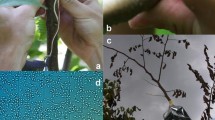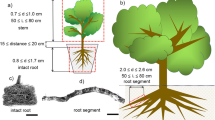Abstract
Xylem dysfunction progresses rapidly in Pinus thunbergii infected with pine wilt disease. The present report deals with the timing and process of the extensive dehydration of tracheids by embolism and the subsequent desiccation of the xylem with disease development. An ultrasonic acoustic emission (AE) technique was used to detect embolisms in the xylem of pine trunks. In most of the P. thunbergii saplings inoculated with the pathogen Bursaphelenchus xylophilus, the AE frequency suddenly increased in the second week after inoculation. The high-frequency AE continued for about 3 days and into the nights. Harvesting of specimens at this time revealed that white air-filled patches, representing the dehydrated and dysfunctional areas, had just emerged in the sapwood. The AE events in the night must be due to something other than embolisms in healthy trees. Frequent embolism of tracheids, which was suggested by the elevation of the AE frequency, might occur due to the decrease in the tensile strength of xylem sap. This hypothesis is supported by previously reported data. Host cells that had reacted to infection with B. xylophilus produce and release chemicals which can lower the surface tension of xylem sap. During the second increase of AEs, most of which occurred in the third week, xylem desiccation and needle yellowing progressed. Needle fading then became distinct, and the tree was close to death when the AE frequency dropped during the fourth week. By monitoring the AE, the first physiological abnormality that took place very early after infection was detected.






Similar content being viewed by others
References
Canny MJ (1995) A new theory for the ascent of sap-cohesion supported by tissue pressures. Ann Bot 75:343–357
Canny MJ (2001) Contributions to the debate on water transport. Am J Bot 88:43–46
Fujii Y (1997) Application of AE monitoring to forest products research. Mokuzai Gakkaishi 43:809–918 (in Japanese)
Fukuda K (1997) Physiological process of the symptom development and resistance mechanism in pine wilt disease. J For Res 2:171–181
Fukuda K, Hogetsu T, Suzuki K (1992) Cavitation and cytological changes in xylem of pine seedlings inoculated with virulent and avirulent isolates of Bursaphelenchus xylophilus and B. mucronatus. J Jpn For Soc 74:289–299
Fukuda K, Utsuzawa S, Sakaue D (2007) Correlation between acoustic emission, water status and xylem embolism in pine wilt disease. Tree Physiol 27:969–976
Hillis WE (1987) Heartwood and tree exudates. Springer, Berlin, p 268
Ikeda T (1996) Xylem dysfunction in Bursaphelenchus xylophilus-infected Pinus thunbergii in relation to xylem cavitation and water status. Ann Phytopathol Soc Jpn 62:554–558
Ikeda T, Oda K (1980) Host attractants for Monochamus alternatus and their application. J Jpn For Soc 62:432–434
Ikeda T, Ohtsu M (1992) Detection of xylem cavitation in field-grown pine trees using the acoustic emission technique. Ecol Res 7:391–395
Jackson GE, Grace J (1996) Field measurements of xylem cavitation: are acoustic emissions useful? J Exp Bot 47:1643–1650
Kiyohara T, Suzuki K (1978) Nematode population growth and disease development in the pine wilting disease. Eur J For Path 8:285–292
Kiyohara T, Tokushige Y (1971) Inoculation experiments of a nematode, Bursaphelenchus sp., onto pine trees. J Jpn For Soc 53:210–218 (in Japanese)
Kuroda K (1989) Terpenoids causing tracheid-cavitation in Pinus thunbergii infected by the pine wood nematode (Bursaphelenchus xylophilus). Ann Phytopathol Soc Jpn 55:170–178
Kuroda K (1991) Mechanism of cavitation development in the pine wilt disease. Eur J For Path 21:82–89
Kuroda K (2008) Pine wilt disease: Part IV (Chap 20: Introduction; Chap 21: Physiological incidences related to symptom development and wilting mechanism). In: Zhao BG, Futai K, Sutherland JR, Takeuchi Y (eds) Pine wilt disease. Springer, Tokyo, pp 202–222
Kuroda K, Ito S (1992) Migration speed of pine wood nematodes and activities of other microbes during the development of pine-wilt disease in Pinus thunbergii. J Jpn For Soc 74:383–389 (in Japanese with English summary)
Kuroda K, Yamada T, Mineo K, Tamura H (1988) Effects of cavitation on the development of pine wilt disease caused by Bursaphelenchus xylophilus. Ann Phytopathol Soc Jpn 54:606–615
Kuroda K, Yamada T, Ito S (1991) Bursaphelenchus xylophilus induced pine wilt: factors associated with resistance. Eur J For Path 21:430–438
Milburn JA (1973) Cavitation studies on whole Ricinus plants by acoustic detection. Planta 112:333–342
Milburn JA (1996) Sap ascent in vascular plants: challengers to the cohesion theory ignore the significance of immature xylem and the recycling of munch water. Ann Bot 78:399–407
National Astronomical Observatory of Japan (2009) Rika Nenpyo. Maruzen, Tokyo, p 1064 (in Japanese; tentative translation of the book title: Scientific tables)
Nobuchi T, Tominaga T, Futai K, Harada H (1984) Cytological study of pathological changes in Japanese black pine (Pinus thunbergii) seedlings after inoculation with pinewood nematode (Bursaphelenchus xylophilus). Bull Kyoto Univ For 56:224–233
Perks MP, Irvine J, Grace J (2004) Xylem acoustic signals from mature Pinus sylvestris during an extended drought. Ann For Sci 61:1–8
Sperry JS, Tyree MT (1988) Mechanism of water stress-induced xylem embolism. Plant Physiol 88:581–587
Sperry JS, Tyree MT (1990) Water-stress-induced xylem embolism in three species of conifers. Plant Cell Environ 13:427–436
Suzuki K (1992) Mechanism of wilting in pine wilt disease. Shinrin-boeki (Forest Pests) 41:59–64 (in Japanese)
Tamura H, Mineo K, Yamada T (1987) Blockage of water conduction in Pinus thunbergii inoculated with Bursaphelenchus xylophilus. Jpn J Nematol 17:23–30
Tyree MT (1997) The cohesion–tension theory of sap ascent: current controversies. J Exp Bot 48:1753–1765
Tyree MT, Sperry JS (1988) Do woody plants operate near the point of catastrophic xylem dysfunction caused by dynamic water stress? Plant Physiol 88:574–580
Tyree MT, Sperry JS (1989) Characterization and propagation of acoustic emission signals in woody plants: towards an improved acoustic emission counter. Plant Cell Environ 12:371–382
Yamada T (2006) Biochemical responses in pines infected with Bursaphelenchus xylophilus. J Jpn For Soc 88:370–382 (in Japanese with English abstract)
Zimmermann MH (1983) Xylem structure and the ascent of sap. Springer, Berlin, p 143
Acknowledgments
I am grateful to Dr. Y. Fujii of Kyoto University for offering his kind advice about selecting AE transducers for living trees, and for demonstrating the method for checking acoustic emissions with an oscilloscope.
Author information
Authors and Affiliations
Corresponding author
Additional information
The present investigation was performed at Kansai Research Center, Forestry and Forest Products Research Institute, Momoyama, Fushimi, Kyoto 612-0855, Japan.
About this article
Cite this article
Kuroda, K. Monitoring of xylem embolism and dysfunction by the acoustic emission technique in Pinus thunbergii inoculated with the pine wood nematode Bursaphelenchus xylophilus . J For Res 17, 58–64 (2012). https://doi.org/10.1007/s10310-010-0246-1
Received:
Accepted:
Published:
Issue Date:
DOI: https://doi.org/10.1007/s10310-010-0246-1




